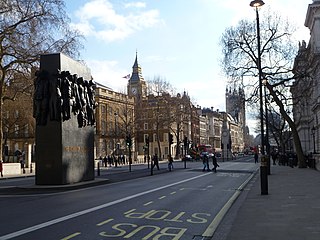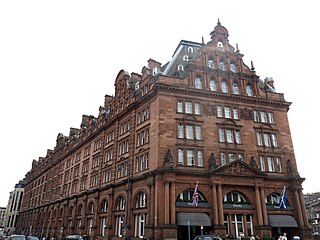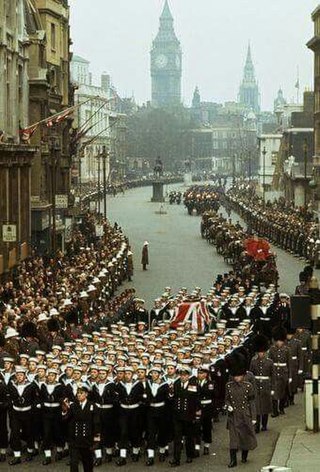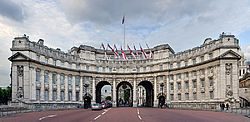
Whitehall is a road and area in the City of Westminster, Central London, England. The road forms the first part of the A3212 road from Trafalgar Square to Chelsea. It is the main thoroughfare running south from Trafalgar Square towards Parliament Square. The street is recognised as the centre of the Government of the United Kingdom and is lined with numerous departments and ministries, including the Ministry of Defence, Horse Guards and the Cabinet Office. Consequently, the name "Whitehall" is used as a metonym for the British civil service and government, and as the geographic name for the surrounding area.

The Mall is a ceremonial route and roadway in the City of Westminster, central London, that travels 1 kilometre (0.62 mi) between Buckingham Palace at its western end and Trafalgar Square via Admiralty Arch to the east. Along the north side of The Mall is green space and St. James's Palace with other official buildings, and to the south is St James's Park. Near the east end at Trafalgar Square and Whitehall it is met by Horse Guards Road and Spring Gardens, near the west end at the Victoria Memorial it is met by the Constitution Hill roadway and the Spur Road to the street of Buckingham Gate. It is closed to traffic on Saturdays, Sundays, public holidays and on ceremonial occasions.

The War Office has referred to several British government organisations in history, all relating to the army. It was a department of the British Government responsible for the administration of the British Army between 1857 and 1964, when its functions were transferred to the new Ministry of Defence (MoD). It was at that time, equivalent to the Admiralty, responsible for the Royal Navy (RN), and the Air Ministry, which oversaw the Royal Air Force (RAF). The name 'War Office' is also given to the former home of the department, located at the junction of Horse Guards Avenue and Whitehall in central London. The landmark building was sold on 1 March 2016 by HM Government for more than £350 million, on a 250 year lease for conversion into a luxury hotel and residential apartments.

The Waldorf Astoria New York is a luxury hotel and condominium residence in Midtown Manhattan in New York City. The structure, at 301 Park Avenue between 49th and 50th Streets, is a 47-story 625 ft (191 m) Art Deco landmark designed by architects Schultze and Weaver, which was completed in 1931. The building was the world's tallest hotel until 1963 when it was surpassed by Moscow's Hotel Ukraina. An icon of glamour and luxury, the Waldorf Astoria is one of the world's most prestigious and best-known hotels. Waldorf Astoria Hotels & Resorts was a division of Hilton Hotels, and a portfolio of high-end properties around the world operates under the name, including in New York City. Both the exterior and the interior of the Waldorf Astoria are designated by the New York City Landmarks Preservation Commission as official landmarks.

William Waldorf Astor, 1st Viscount Astor was an American-English attorney, politician, businessman, and philanthropist. Astor was a scion of the very wealthy Astor family of New York City. He moved to England in 1891, became a British subject in 1899, and was made a peer as Baron Astor in 1916 and Viscount Astor in 1917 for his contributions to war charities.

Mandarin Oriental Hotel Group International Limited is a multinational hospitality and management group focusing on luxury hotels, resorts, and residences, with a total of 34 properties worldwide, 20 of which it wholly or partially owns.

Carlton House, sometimes Carlton Palace, was a mansion in Westminster, best known as the town residence of King George IV, particularly during the regency era and his time as prince regent. It faced the south side of Pall Mall, and its gardens abutted St James's Park in the St James's district of London. The location of the house, now replaced by Carlton House Terrace, was a main reason for the creation of John Nash's ceremonial route from St James's to Regent's Park via Regent Street, Portland Place and Park Square: Lower Regent Street and Waterloo Place were originally laid out to form the approach to its front entrance.

The Victoria Memorial is a monument to Queen Victoria, located at the end of The Mall in London by the sculptor Sir Thomas Brock. Designed in 1901, it was unveiled on 16 May 1911, though it was not completed until 1924. It was the centrepiece of an ambitious urban planning scheme, which included the creation of the Queen’s Gardens to a design by Sir Aston Webb, and the refacing of Buckingham Palace by the same architect.

Northumberland Avenue is a street in the City of Westminster, Central London, running from Trafalgar Square in the west to the Thames Embankment in the east. The road was built on the site of Northumberland House, the London home of the Percy family, the Dukes of Northumberland between 1874 and 1876, and on part of the parallel Northumberland Street.
Waldorf Astoria Hotels & Resorts, formerly The Waldorf-Astoria Collection, is a luxury hotel and resort brand of Hilton Worldwide. It is positioned as the flagship brand within Hilton's portfolio, being used on hotels which offer the highest standards of facilities and service. As of December 31, 2019, it had 32 locations with 9,821 rooms in 15 countries and territories, including 2 that are owned or leased and 30 that are managed.

Spring Gardens is a dead-end street at the south east extreme of St. James's, London, England, that crosses the east end of The Mall between Admiralty Arch and Trafalgar Square. Part of the old liberty of Westminster and the current City of Westminster, it abuts Whitehall, Horse Guards Parade, Green Park, and the Charing Cross/Strand/Trafalgar Square locality.

The Bentley London is a luxury hotel in London, England, located in South Kensington. The hotel contains 64 rooms. The building was constructed in 1880, joined the Hilton Group as a franchise in October 2008 and was added to the Waldorf-Astoria collection on 12 March 2009. As of January 2012, The Bentley Hotel is a standalone hotel with no association with Hilton or Waldorf Astoria.

In the United Kingdom, state funerals are usually reserved for monarchs. The most recent was the state funeral of Queen Elizabeth II on 19 September 2022.
The London Noses or Seven Noses of Soho are an artistic installation found on buildings in London. They are plaster of Paris reproductions of the artist's nose which protrude from walls in an incongruous and unexpected way. They were created by artist Rick Buckley in 1997. Initially, about 35 were attached to buildings such as the National Gallery and Tate Britain but by 2011 only about 10 survived.

Rafael Serrano Quevedo is a Spanish businessman and investor.

Waldorf Astoria Edinburgh - The Caledonian is a five-star hotel in Edinburgh, Scotland. Opened in December 1903, it is an example of a British grand railway hotel, formerly called The Caledonian Hotel, and nicknamed 'The Caley'. It stands at the west end of Princes Street and is a category A listed building.

The official residence of the United States Ambassador to the United Nations, established in 1947, was originally located in a suite of rooms on the 42nd floor of the Waldorf-Astoria Hotel in New York City leased by the U.S. Department of State. Described in press reports as "palatial", the ambassadorial residence was the first one to be located in a hotel. The Department of State vacated the Waldorf Astoria shortly after the Chinese Anbang Insurance Company purchased the Waldorf-Astoria in 2015, raising security concerns. The United States purchased a penthouse apartment at 50 United Nations Plaza in May 2019 after initially renting a different penthouse apartment in the same building.

Waldorf Astoria Amsterdam is a five-star luxury hotel in Amsterdam, part of Hilton Worldwide.

The Royal Navy State Funeral Gun Carriage is a converted Ordnance, BL, 12 pdr 6 cwt, MK II, gun carriage which has been used in the UK to bear the coffin at the funeral processions of Queen Victoria, King Edward VII, King George V, King George VI, Sir Winston Churchill, Lord Mountbatten, and Queen Elizabeth II. It is traditionally pulled by members of the Royal Navy; when not in use, it is kept at the shore establishment HMS Excellent. A smaller version, known as the Portsmouth Gun Carriage, has been used at the ceremonial funerals of several senior naval officers in the 20th century.

The Admiralty buildings complex lies between Whitehall, Horse Guards Parade and The Mall and includes five inter-connected buildings.






















